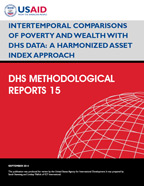- PUBLICATIONS
- JOURNAL ARTICLES
- ACCESS PUBLICATIONS
Publications Summary
- Document Type
- Methodological Reports
- Publication Topic(s)
- Household and Respondent Characteristics, Wealth/Socioeconomics
- Country(s)
- Cameroon, Ghana, Zimbabwe, Egypt, Bangladesh, Indonesia, Nepal, Bolivia
- Language
- English
- Recommended Citation
- Staveteig, Sarah and Lindsay Mallick. 2014. Intertemporal Comparisons of Wealth with DHS Data: A Harmonized Asset Index Approach. DHS Methodological Reports No. 15. Rockville, Maryland, USA: ICF International.
- Download Citation
- RIS format / Text format / Endnote format
- Publication Date
- September 2014
- Publication ID
- MR15
Download
 Intertemporal Comparisons of Poverty and Wealth with DHS Data: A Harmonized Asset Index Approach (PDF, 872K)
Intertemporal Comparisons of Poverty and Wealth with DHS Data: A Harmonized Asset Index Approach (PDF, 872K)
